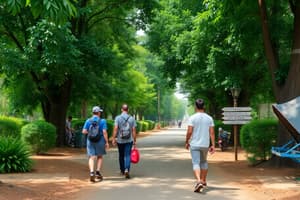Podcast
Questions and Answers
What does discretionary income refer to in the context of tourism?
What does discretionary income refer to in the context of tourism?
- The amount of money left after all essential expenses have been paid. (correct)
- The total income a person earns before any expenses.
- The income specifically allocated for leisure activities.
- The savings accumulated for future travel.
Which of the following is NOT categorized as a travel motivator according to McIntosh's classification?
Which of the following is NOT categorized as a travel motivator according to McIntosh's classification?
- Interpersonal Motivators
- Physical Motivators
- Environmental Motivators (correct)
- Cultural Motivators
How does motivation influence an individual's decision to travel?
How does motivation influence an individual's decision to travel?
- It drives the reasons behind choosing a travel destination. (correct)
- It ensures the availability of transportation.
- It eliminates the need for travel documents.
- It determines the amount of discretionary income available.
Which travel motivator focuses on the desire to make new friends or escape daily life?
Which travel motivator focuses on the desire to make new friends or escape daily life?
What factor is considered essential for a tourist's mobility?
What factor is considered essential for a tourist's mobility?
According to the Push and Pull Theory, what do 'push factors' typically refer to?
According to the Push and Pull Theory, what do 'push factors' typically refer to?
Which of the following best represents physical motivators in travel?
Which of the following best represents physical motivators in travel?
What is one common effect of changes in workdays on tourism?
What is one common effect of changes in workdays on tourism?
What are push factors in the context of travel?
What are push factors in the context of travel?
Which of the following is a pull factor related to tourism?
Which of the following is a pull factor related to tourism?
In McIntosh's Travel Motivation Classification, which category represents the desire for personal growth?
In McIntosh's Travel Motivation Classification, which category represents the desire for personal growth?
What does the facilities factor in pull factors refer to?
What does the facilities factor in pull factors refer to?
How does the tourism industry contribute to economic progress?
How does the tourism industry contribute to economic progress?
Which of the following is NOT considered a core attractions factor?
Which of the following is NOT considered a core attractions factor?
Which of these is a push factor related to social interaction?
Which of these is a push factor related to social interaction?
What role does landscape features factor play in pull factors?
What role does landscape features factor play in pull factors?
What does seasonality refer to in the context of tourism?
What does seasonality refer to in the context of tourism?
How do suppliers of tourism services generally adjust their pricing strategy during peak season?
How do suppliers of tourism services generally adjust their pricing strategy during peak season?
Which statement best describes the ownership aspect when purchasing hotel stays or airline tickets?
Which statement best describes the ownership aspect when purchasing hotel stays or airline tickets?
Why do tourism products require collaboration among multiple sectors?
Why do tourism products require collaboration among multiple sectors?
What effect does seasonality typically have on tourism employment?
What effect does seasonality typically have on tourism employment?
Which pricing strategy is commonly used by hotels during the off-season?
Which pricing strategy is commonly used by hotels during the off-season?
In relation to McIntosh's Travel Motivation Classification, which of the following motivations might drive someone to travel?
In relation to McIntosh's Travel Motivation Classification, which of the following motivations might drive someone to travel?
What are push and pull factors in travel motivation?
What are push and pull factors in travel motivation?
Flashcards are hidden until you start studying
Study Notes
Requirements for Tourism
- Time: Increased leisure hours allow more travel opportunities; influenced by work and school schedules.
- Money: Travel requires discretionary income, the leftover money after essential expenses are covered.
- Mobility: Access to transportation and travel time affects destination reachability.
- Motivation: Drivers for travel can include adventure, education, new experiences, or stress relief.
- Documents: Essential travel documents include passports, visas, airline tickets, and booking reservations.
Travel Motivators
- Categories of Motivations: Dr. Robert W. McIntosh divides travel motivations into four main types:
- Physical Motivators: Focus on health and well-being, including relaxation, sports, and medical treatments.
- Interpersonal Motivators: Desire for social connections, visiting friends and family, or escaping daily life.
- Cultural Motivators: Curiosity about different cultures, traditions, and artistic expressions.
- Status and Prestige Motivators: Pursuit of self-esteem, professional interests, or gaining fame.
Push and Pull Theory
- Push Factors: Internal drivers that initiate travel desires, such as self-exploration, relaxation, family visits, and cultural experiences.
- Pull Factors: External attractions that encourage travel, categorized as:
- Facilities Factor: Available tourism amenities like accommodations, dining, and transportation.
- Core Attractions Factor: Activities, nightlife, and entertainment opportunities at destinations.
- Landscape Features Factor: Natural geographical features like beaches, mountains, and forests.
Importance of the Tourism and Hospitality Industry
- Economic Progress: Tourism helps generate foreign exchange and contributes significantly to national economies through visitor spending.
- Technological Integration: Advanced reservation systems reduce human error, maintain service standards, and streamline travel arrangements.
- Absence of Ownership: Tourists purchase rights to services (like accommodations or flights) rather than ownership, emphasizing the contractual nature of travel.
- Manufactured by Many Producers: Tourism products involve multiple specialized services, indicating a collaborative industry structure (e.g., travel agents coordinating multiple sectors).
- Seasonality: Seasonal trends impact business cycles, often leading to fluctuating demand and pricing strategies based on peak and off-peak seasons.
Studying That Suits You
Use AI to generate personalized quizzes and flashcards to suit your learning preferences.




